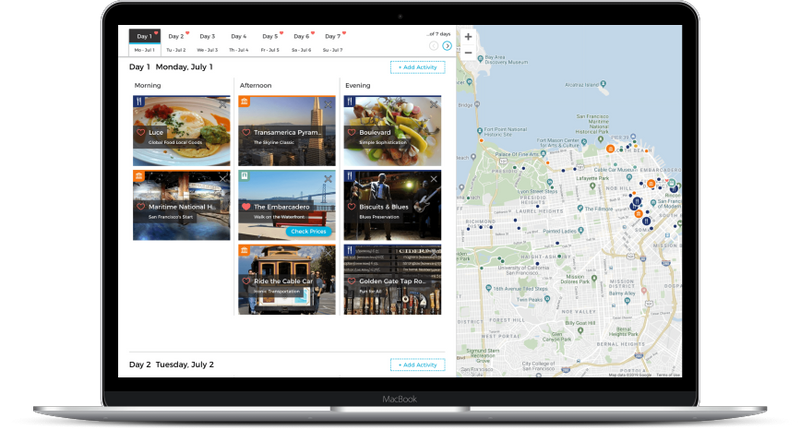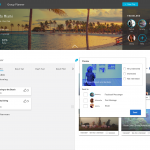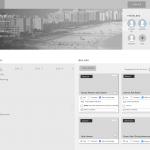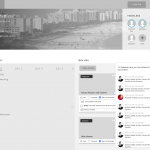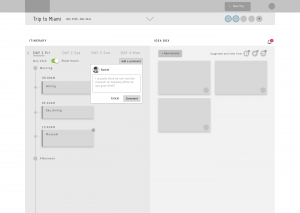Copilot Trip Planner
Get your trip together. Together.
Travel planning can be a frustrating experience, especially when you need to coordinate with a group of people. It doesn’t take long to discover that everyone has different priorities and preferences, and it can be tough to stay organized.
Copilot is a tool that makes group trip planning simple and delightful by facilitating collaboration and leveraging existing communication technology.
Travel planners can use Copilot to generate ideas for trip activities, organize them, and get feedback from members of their group on the platforms they already use, such as Facebook Messenger, email, and text messaging.

My Role
I led our design prototyping efforts, working with two other designers to build out a series of sketches and paper prototypes. After we felt we had a solid concept, I built a high-fidelity HTML prototype that we used for further testing.
I also worked alongside a user researcher and project manager to conduct semi-structured user interviews and an online survey to gather insights about our target audience. Additionally, I helped conduct user tests on our prototypes using the RITE method.
Methods and Skills
- Semi-structured interviews
- Online surveys
- Sketching
- User journey mapping
- Interaction design (Sketch)
- Paper prototyping
- HTML prototyping
The trouble with travel
We conducted 8 one-on-one semi-structured interviews with people who had group trip planning experience followed by a competitive analysis of 8 of the top trip planning products currently available. Finally, we distributed a 44-question branching-logic survey, receiving 284 responses.
These research activities helped us identify several challenges that our target audience encounters when trying to plan a trip, including:
Following the leader
Travel groups typically have one key organizer who takes the lead on planning. This person often must use a variety of methods and resources to explore activities, gather ideas, and test out itineraries, which can lead to a process that is disorganized, confusing and frustrating.
Communication frustration
People who travel together often don't align with each other in terms of their preferred means of communication. This results in extra work for the group leader having to use many disparate methods to communicate, including emails, text messages, and social media.
Decisions, decisions
Collaborative trip planning involves a lot of group decision making. However, group leaders often have difficulty gauging the interest levels of individual group members in any particular idea, which makes it difficult to finalize decisions.
These issues led us to define our design problem:
How might we improve the planning experience for people who travel together?
The framework
In order to help us address this design problem, we developed a simple user journey map to break down the travel planning process into five key stages, which we used as a framework for our project. Although we addressed all stages of the process to some degree, we decided to put our emphasis on the collaborative aspects of the last three stages due to short time frames.

Inspiration
Group members identify and aggregate ideas for things they want to do and see during their trip. These can come from a wide variety of sources: recommendations from friends, online travel forums, and much more.
Research
Trip planners take the ideas they have identified and research them. They get more information about their proximity and the time required to complete the activity. They read reviews and consider alternatives.
Ask Opinions
The leader gauges interest levels from all members of the group to see which of the identified activities are things that the group can all enjoy.
Plan
The group leader takes the most interesting and popular ideas and tries to fit them into an itinerary, taking into account the time and transportation considerations.
Agreement
The group leader socializes the itinerary with the group, driving towards a consensus on what the final plan for the trip should be.
From ideas to itineraries
Our research helped us to define a common path that trip planners take when planning a vacation, as well as many of the issues that they run in to along the way. The Copilot experience required that trip organizers had a space where they could explore activities, gather ideas, and test out itineraries. I sketched out several ideas showing how the flow from ideas to itineraries might work, then came together with the other designers in my group to compare ideas. These discussions helped us to settle on the key functions for the core Copilot experience.
Activity Exploration
The group leader can identify ideas for things they want to do and see during their trip by using the "new activity" feature.

The idea box
Activity ideas are displayed as cards in a box, where they can be aggregated, shuffled and organized in meaningful and customized ways.

Collaborating for consensus
Communicating ideas and reaching agreement on potential itineraries to group members was always going to be a big challenge for group leaders, since each person might have a different preferred communication platform that might even change frequently depending on where they are at any given time. For example, a single group member might prefer email while at work, text message while at the gym, and Facebook while at home.
Cross-channel communication
Copilot lets planners send messages to the rest of the group on the platform that they prefer, whether it be email, text message, or social media options.
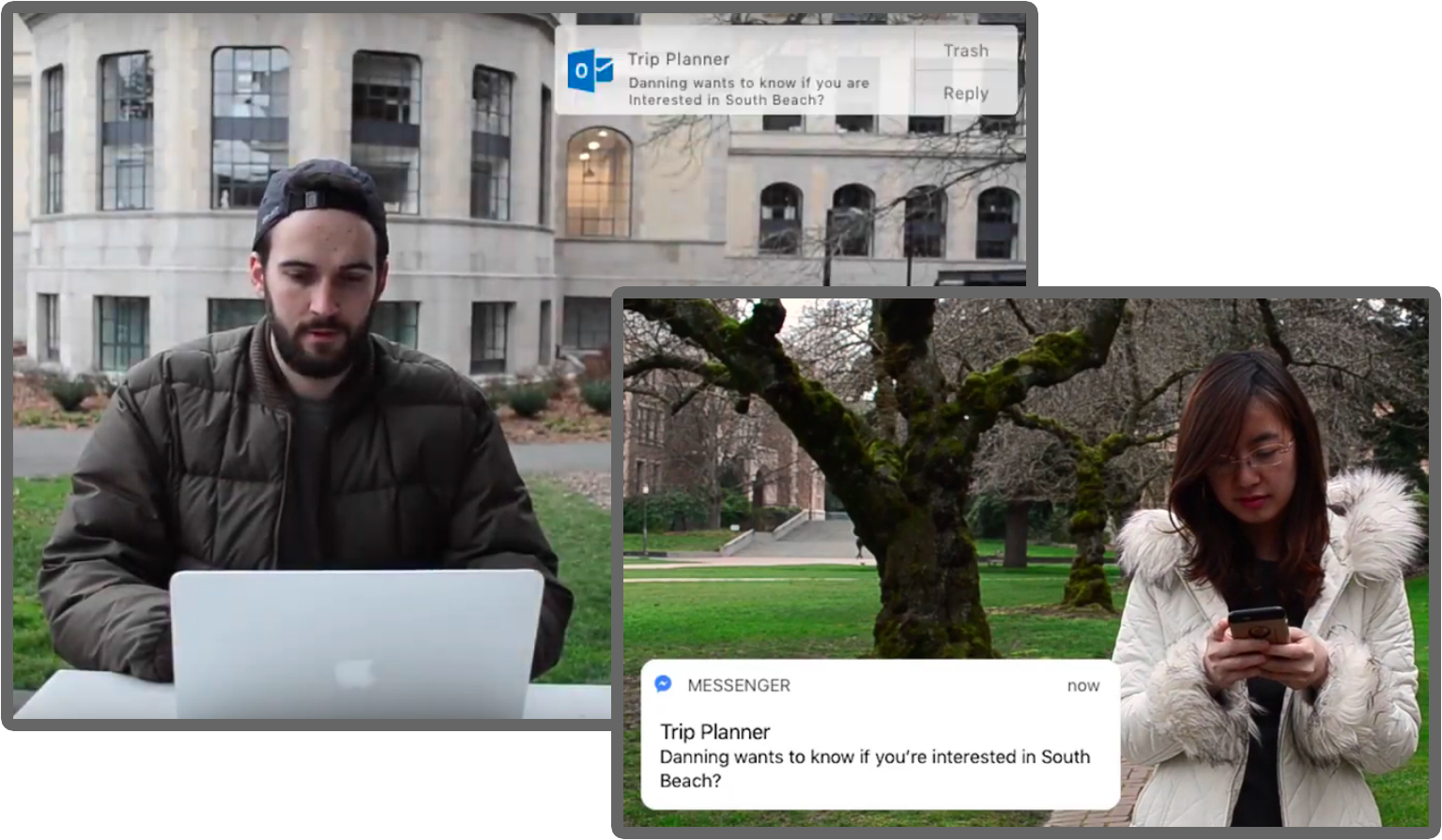
Polling for preferences
When it's time for group members to weigh in with their opinions, leaders can send mini-surveys to quickly determine which ideas are most popular to the group.

Lessons learned
Less guessing, more testing
About mid-way through the project, we spent a lot of time second-guessing some of the assumptions we had made about the technologies people communicate travel ideas. In retrospect, we felt that we likely would have arrived at the same conclusions through more user testing rather than spending a significant amount of time second guessing our project’s direction.
Scope for simplicity
When we began this project, our scope was intentionally broad because, as designers who love to travel, we had a desire to address many of the most frustrating aspects of collaborative planning. However, we could have spent more time building a solution if we had we started with a narrower and well-defined scope in the first place.
Trust the team
In general, I tend to take on too much because I trust my own abilities and work ethic. However, working with a highly talented and motivated team helped me to learn to trust others to do their part, which allowed us to ultimately be more productive and achieve much more. As a bonus, I developed worthwhile relationships that I can rely on throughout my career.
The impact of Copilot
Many of our ideas from our Copilot project served as a foundation for improving Utrip's itinerary planner, such as the trip planning framework, the idea box, and more broadly time boxing activity buckets on the itinerary. These changes resulted in an increase in engagement and time-on-page of over 200% on Utrip's itinerary tool.
